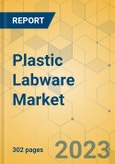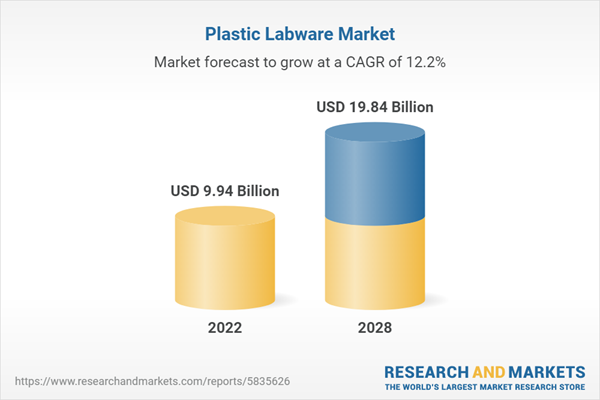Speak directly to the analyst to clarify any post sales queries you may have.
MARKET TRENDS & OPPORTUNITIES
Increased Investments in R&D
Increased research and development (R&D) operations for plastic labware have increased demand globally for these items. Researchers and scientists have been drawn to creating novel and modern plastic labware with better features and usefulness, resulting in increased demand for these goods.Plastic labware producers are investing in R&D to develop products that can endure severe temperatures, resist chemical corrosion, and have increased precision and repeatability as technology advances and new materials emerge. Advancements in the plastic labware market have broadened its usage outside typical laboratory settings, such as in the medical and biotechnology sectors. Increased R&D activity for plastic labware has also created eco-friendly and biodegradable goods, addressing the environmental problems connected with traditional plastic labware. This breakthrough has piqued the interest of governments and institutions seeking to lower their carbon impact.
Rising Preference for Plasticware
Manufacturers improve the quality of test findings while enhancing the value of their products by altering the surface qualities of polymer labware. One of the things boosting the value of plastic labware is plasma treatment. Millions of multi-well plates, pipettes, flasks, bottles, vials, culture plates, Eppendorf tubes, and other polymer labware products are produced annually for research, drug development, and diagnostic testing. Although many are simple, low-cost consumables, a growing percentage are now surface treated with gas plasma or have functional coatings that are precisely constructed to improve research quality and diagnostic sophistication. Traditional glassware is composed of borosilicate glass, which is non-recyclable because of its heat-resistant qualities.INDUSTRY RESTRAINTS
Stringent Regulations
Plastic labware legislation differs by country; however, there is a global movement towards decreasing the use of single-use plastics and encouraging sustainability. Manufacturers must adapt to these restrictions to remain competitive in the plastic labware market and invest in sustainable alternatives.Plastic-related rules and legislation have recently been established in several nations, regions, and towns. These are designed primarily to reduce consumption and improve waste management through use and disposal. Over 60 countries have banned or taxed plastic packaging and single-use/disposable garbage. These restrictions and standards make it more difficult for plastic labware producers to function in the market. They must adhere to laws, which can raise production costs and impact product prices. Furthermore, the regulations and guidelines make marketing plastic labware products to increasingly environmentally conscious customers who prefer eco-friendly or biodegradable alternatives more difficult.
SEGMENTATION INSIGHTS
INSIGHTS BY PRODUCT TYPE
The global plastic labware market by product type is divided into consumables, reusables, and others. These classifications are based on the intended usage of plastic labware goods. Consumables are plastic labware products for single-use applications sold in APAC and Europe. They are disposable and are thrown away after usage. Plastic pipettes, Petri dishes, sample cups, test tubes, and other similar items are examples of consumables. They're common in clinical and diagnostic labs, university research labs, and the biotechnology and pharmaceutical sectors. Due to an increase in patient population, an increase in chronic diseases, an increase in government initiatives in the health care sector, an increase in the number of diagnostic laboratories, and an increase in research and development activities in core industries, as well as usage on academia, emerging economies offer greater opportunities to the laboratory consumable products market.Segmentation by Product
- Consumable
- Reusable
- Others
INSIGHTS BY MATERIAL
The global plastic labware market may be divided into segments depending on the materials used to make the items. Polystyrene is extensively utilized in cell culture and microbiology, although polypropylene is favored in chemical and biochemical applications. Polyethylene is used in clinical and diagnostic laboratories because of its low cost and durability. Polycarbonate, PVC, and other materials used in plastic labware are used for various purposes.Segmentation by Material
- Polystyrene
- LDPE
- HDPE
- PP
- Others
INSIGHTS BY END-USERS
The academia and research held the largest global plastic labware market share in the end-users segment, accounting for over 30% in 2022. A primary reason driving the growth of general laboratory equipment is the rising demand from quality testing and research laboratories in manufacturing industries such as the pharmaceutical sector. At the onset of the pandemic, substantial study is being conducted. Ongoing progress in new medication discovery and vaccine development boosts demand for laboratory equipment from these end-use sectors.Segmentation by End-users
- Academia/Research
- Pharmaceutical
- CROs
- IVF Clinics
- Diagnostic Labs
- Others
INSIGHTS BY DISTRIBUTION CHANNEL
The producer directly sells plastic labware to end-users such as laboratories, research institutions, and hospitals through direct distribution channels in the global plastic labware market. The producer controls the product's pricing, advertising, and distribution. Direct distribution channels enable manufacturers to have a stronger contact with their customers, collect product feedback, and better understand their requirements and preferences. In B2B sales, direct distribution methods are more frequent.Indirect distribution methods, on the other hand, require the employment of middlemen to supply plastic labware to end users. Wholesalers, distributors, and retailers are examples of intermediaries in the global plastic labware market. These middlemen buy plastic labware in bulk from the manufacturer and resell it to end users at a higher price. In B2C sales, indirect distribution methods are increasingly frequent.
Segmentation by Distribution Channel
- Direct Channel
- Indirect Channel
GEOGRAPHICAL ANALYSIS
North America is expected to dominate the global plastic labware market, accounting for over 33% share in 2022. Factors such as the rising number of diagnostic tests, increased usage of laboratory consumables, and the introduction of specially designed plasticware are driving the growth of the plastic labware market in the region. The U.S. and Canada are the major countries in this region. North America has been one of the leaders in innovation and research. To retain its top position, the U.S. is continuing to invest in R&D, which is expected to boost the plastic labware market in the region during the forecast period.Segmentation by Geography
- North America
- The U.S.
- Canada
- APAC
- China
- Japan
- India
- South Korea
- Australia
- Singapore
- Rest of APAC
- Europe
- Germany
- France
- The U.K.
- Italy
- Spain
- Russia
- Netherlands
- Rest of Europe
- Latin America
- Brazil
- Mexico
- Argentina
- Middle East & Africa
- UAE
- Saudi Arabia
- South Africa
- Rest of the Middle East & Africa
COMPETITIVE LANDSCAPE
The global plastic labware market is extremely competitive, with many manufacturers and suppliers participating. In addition to the market's major companies like Thermo Fisher Scientific, Eppendorf, and others, there are many smaller producers and suppliers. These businesses may specialize in certain types of plasticware or operate in specific geographic areas.Key Company Profiles
- Bellco Glass
- Corning
- DWK Life Sciences
- Sartorius
- Thermo Fisher Scientific
Other Prominent Vendors
- Borosil
- Citotest Labware Manufacturing
- Crystalgen
- DELUXE SCIENTIFIC SURGICO
- Eppendorf
- Glacier Glass Works
- Glassco Laboratory Equipments
- METTLER TOLEDO
- Naugraexport
- PerkinElmer
- Quark Glass
- Bel-Art Products
- Tarsons
- Greiner Bio-One International
- VWR International
- BrandTech Scientific
- KARTELL
- Polylab
- KANGJIAN Medical Apparatus
- Labcon North America
- Pipettes.com
- Simport Scientific
- SPL LIFE SCIENCES
- Labnet
- CELLTREAT Scientific Products
- Gilson
- Bio-Rad Laboratories
- Socorex Isba
- Medline Industries
KEY QUESTIONS ANSWERED:
- How big is the plastic labware market?
- What is the growth rate of the global plastic labware market?
- What are the growing trends in the plastic labware industry?
- Which region holds the most significant global plastic labware market share?
- Who are the key players in the global plastic labware market?
Table of Contents
Companies Mentioned
- Bellco Glass
- Corning
- DWK Life Sciences
- Sartorius
- Thermo Fisher Scientific
- Borosil
- Citotest Labware Manufacturing
- Crystalgen
- DELUXE SCIENTIFIC SURGICO
- Eppendorf
- Glacier Glass Works
- Glassco Laboratory Equipments
- METTLER TOLEDO
- Naugraexport
- PerkinElmer
- Quark Glass
- Bel-Art Products
- Tarsons
- Greiner Bio-One International
- VWR International
- BrandTech Scientific
- KARTELL
- Polylab
- KANGJIAN Medical Apparatus
- Labcon North America
- Pipettes.com
- Simport Scientific
- SPL LIFE SCIENCES
- Labnet
- CELLTREAT Scientific Products
- Gilson
- Bio-Rad Laboratories
- Socorex Isba
- Medline Industries
Methodology
Our research comprises a mix of primary and secondary research. The secondary research sources that are typically referred to include, but are not limited to, company websites, annual reports, financial reports, company pipeline charts, broker reports, investor presentations and SEC filings, journals and conferences, internal proprietary databases, news articles, press releases, and webcasts specific to the companies operating in any given market.
Primary research involves email interactions with the industry participants across major geographies. The participants who typically take part in such a process include, but are not limited to, CEOs, VPs, business development managers, market intelligence managers, and national sales managers. We primarily rely on internal research work and internal databases that we have populated over the years. We cross-verify our secondary research findings with the primary respondents participating in the study.

LOADING...
Table Information
| Report Attribute | Details |
|---|---|
| No. of Pages | 302 |
| Published | June 2023 |
| Forecast Period | 2022 - 2028 |
| Estimated Market Value ( USD | $ 9.94 Billion |
| Forecasted Market Value ( USD | $ 19.84 Billion |
| Compound Annual Growth Rate | 12.2% |
| Regions Covered | Global |
| No. of Companies Mentioned | 34 |









